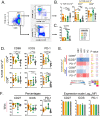This is a preprint.
Chronic viral infection compromises the quality of circulating mucosal-invariant T cells and follicular T helper cells via expression of both activating and inhibitory receptors
- PMID: 37163092
- PMCID: PMC10168456
- DOI: 10.21203/rs.3.rs-2862719/v1
Chronic viral infection compromises the quality of circulating mucosal-invariant T cells and follicular T helper cells via expression of both activating and inhibitory receptors
Update in
-
Chronic Viral Infection Compromises the Quality of Circulating Mucosal-Associated Invariant T Cells and Follicular T Helper Cells via Expression of Inhibitory Receptors.Front Biosci (Landmark Ed). 2024 Mar 22;29(3):128. doi: 10.31083/j.fbl2903128. Front Biosci (Landmark Ed). 2024. PMID: 38538288
Abstract
Chronic viral infection results in impaired immune responses rendering viral persistence. Here, we investigated the role of immune activation and compared the quality of T-cell responses in chronic HBV, HCV, and HIV infections. Cytokines were measured using a commercial Bio-plex Pro Human Cytokine Grp I Panel 17-plex kit (BioRad, Hercules, CA, USA). Inflammation was assessed by measuring an array of plasma cytokines, and peripheral CD4+ T cells including circulating Tfh cells, CD8+ T cells, and TCR iVα7.2+ MAIT cells in chronic HBV, HCV, and HIV-infected patients and healthy controls. The cells were characterized based markers pertaining to immune activation (CD69, ICOS, and CD27) proliferation (Ki67), cytokine production (TNF-α, IFN-γ) and exhaustion (PD-1). The cytokine levels and T cell phenotypes together with cell markers were correlated with surrogate markers of disease progression. The activation marker CD69 was significantly increased in CD4+ hi T cells, while CD8+ MAIT cells expressing IFN-γ were significantly increased in chronic HBV, HCV and HIV infections. Six cell phenotypes, viz., TNF-α+CD4+ lo T cells, CD69+CD8+ T cells, CD69+CD4+ MAIT cells, PD-1+CD4+ hi T cells, PD-1+CD8+ T cells, Ki67+CD4+ MAIT cells were independently associated with decelerating the plasma viral load (PVL). TNF-α levels showed a positive correlation with increase in cytokine levels and decrease in PVL. Chronic viral infection negatively impacts the quality of peripheral MAIT cells and TFH cells via expression of both activating and inhibitory receptors.
Keywords: HBV; HIV; MAIT cells; PD-1; T cell exhaustion.
Conflict of interest statement
Declarations Disclosure statement The authors declare that the research was conducted in the absence of any commercial or financial relationships that could be construed as a potential conflict of interest.
Figures





References
-
- Boldogh I, Albrecht T, Porter DD. Persistent Viral Infections. In: Baron S, editor. Medical Microbiology. 4th edition. Galveston (TX): University of Texas Medical Branch at Galveston; 1996. Chapter 46. Available from: www.ncbi.nlm.nih.gov/books/NBK8538/ - PubMed
-
- Mysore KR, Leung DH. Hepatitis B and C. Clin Liver Dis. 2018;22(4):703–722. - PubMed
Publication types
Grants and funding
LinkOut - more resources
Full Text Sources
Research Materials

